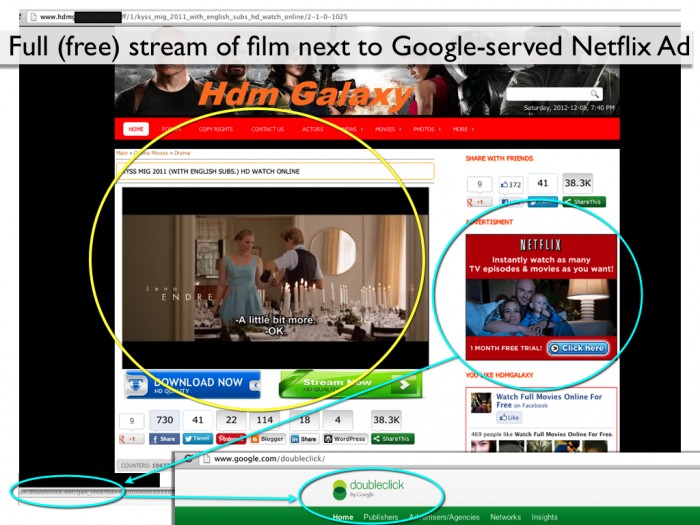 I was happy to see today’s “Advertising Transparency Report” issued by USC’s Annenberg Innovation Lab that documents the flow of ad dollars from legit companies to pirate websites. According to the report:
I was happy to see today’s “Advertising Transparency Report” issued by USC’s Annenberg Innovation Lab that documents the flow of ad dollars from legit companies to pirate websites. According to the report:
…many major brands are not aware that they are in fact the key source of funds for the Piracy industry, it is the goal of this “transparency report” to aid in helping these brands steer their ad dollars away from sites that exploit film, TV and music artists for what appears to be criminal gain.
Though I applaud the report’s overall findings that ad dollars incentivize and subsidize online piracy, I question the conclusion that “major brands” were not “aware that they are in fact the key source of funds for the Piracy industry.” As I’ve noted in the past, advertisers are usually extremely careful, and cognizant, about where their advertising appears. Why the sudden lack of concern for their ad placements online?
More than two years ago I was inspired to start this blog to document this very issue. As an indie filmmaker facing piracy, it didn’t take me long to recognize there was a major link between ad dollars and the growth of online piracy. I attempted to answer the question “Who Profits from Piracy?” From my introduction:
Online piracy isn’t about altruism, it’s about income. Today’s technology allows web pirates to steal content and monetize that content with a click of a mouse. Meanwhile, “legit” companies encourage and facilitate this theft while also profiting from it (ad service providers, advertisers and payment processors). The time has come for reasonable measures to be taken to discourage this theft. Content creators and consumers will benefit. Only the pirates and those who profit from their theft will lose.
I wrote that in June of 2010. Yet here we are, nearly three years later, and what has changed? Reading the latest news, it appears the answer is, “not much.” According to the LA Times Levi’s was said to surprised by the report’s findings and contacted their ad agency and instructed them to take immediate action to prevent their ads from appear on illegal file-sharing websites. Was Levi’s really surprised–and more important–will other companies finally follow suit? Forgive me if I remain skeptical. The fact that ad dollars fuel online piracy is not news.
This video (found on the introduction to this blog) is based on a presentation I gave at Canadian Music Week’s Global Forum in the spring of 2011. It documents my journey through the landscape of online piracy and its undeniable link to advertising revenues. Follow the money…
Some progress has been made since then, most notably, last year’s takedown of Megaupload–the Big Daddy of illegal file sharing. It’s worth noting at this juncture, that Megaupload’s millions were generated in large measure by ad dollars (as well as subscription fees). Numerous copycat websites have sprung up to fill the void left by Megaupload, and they too depend business models sustained by advertising dollars. With the demise of legislative efforts to address this black market, content creators are left with little recourse.
Back in 2010 I attempted to contact advertisers like Netflix and others whose ads were, and still are, ubiquitous on numerous illegal download sites. Most of my efforts were ignored, but on July of 2010, after NPR aired a story about my blog on “All Things Considered” that mentioned Netflix ads; I received an email from Steve Swasey, their VP of Corporate Communications who wrote the following:
Netflix does not tolerate piracy and we do not support pirate sites. We are very clear with our advertising agencies and affiliate partners about this. Sometimes ads slip through and when this happens, we react swiftly and decisively, removing the ad and not paying the site.
Again, that was over two years ago. Yet here’s an example of a Netflix ad (served by Google) on a pirate site I here last month. The ad appears alongside an embedded, full stream of a pirated film, “Kyss Mig.” As I said, not much seems to have changed.
We’ll see if this latest report from Annenberg precipitates real change. I did take heart by looking at the results of an unofficial poll that accompanied the LA Times piece asking readers: “Should brands avoid advertising on so-called pirate sites?” As of now, 63% said yes, while 37% said no. Perhaps there reason to hope, that at long last, the balance could shift away from an insidious equation where everyone, except the actual content creators, make money from online theft. When presented with clear and tangible evidence, the public seems to be on the side of creators. Yet in this game, for any real progress to be made, the ball remains squarely in the advertisers’ court.

